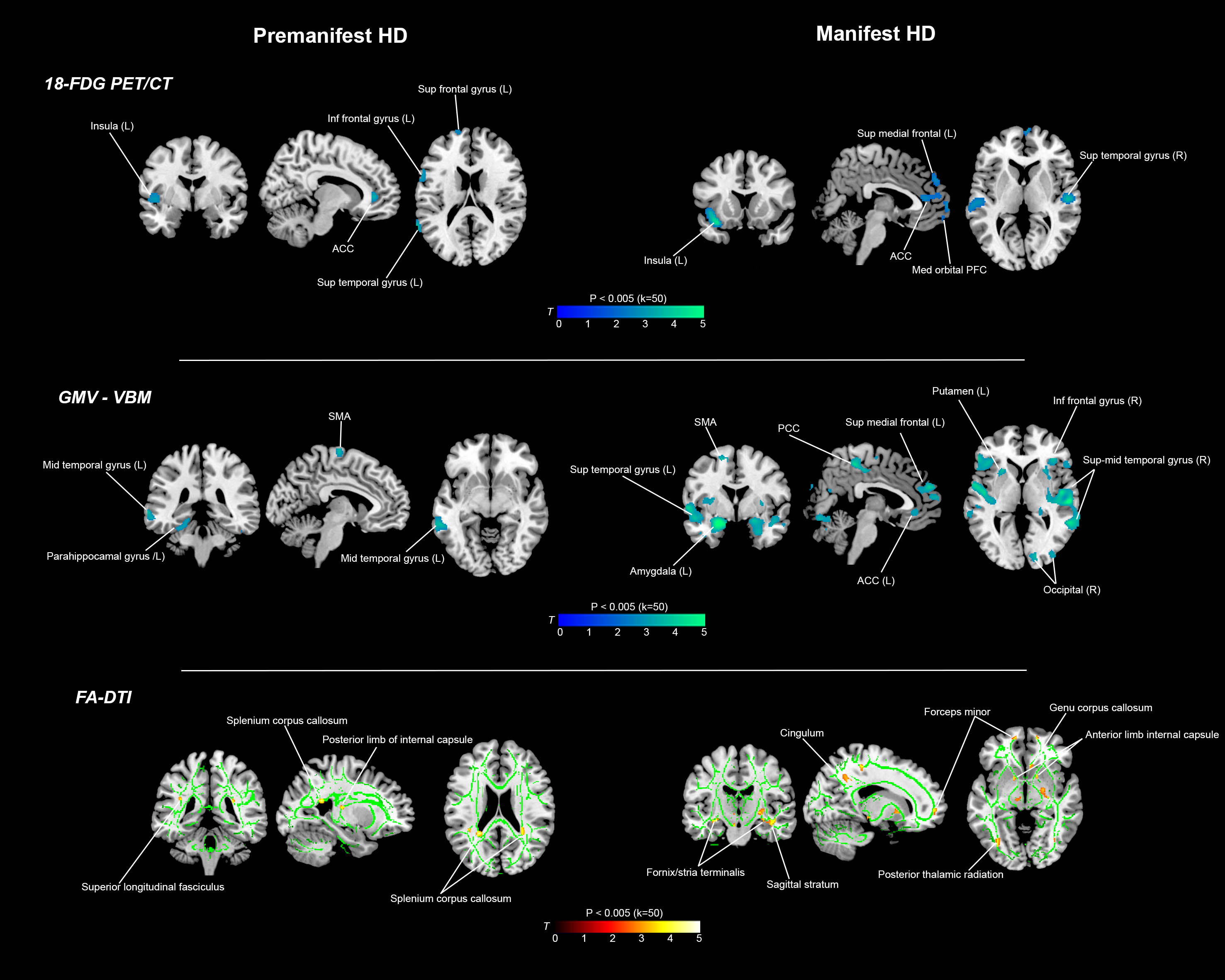Session Information
Date: Tuesday, June 6, 2017
Session Title: Huntington's Disease
Session Time: 1:45pm-3:15pm
Location: Exhibit Hall C
Objective: To delineate the brain correlates of apathy severity by means of glucose metabolism (18-FDG PET), grey-matter (GM) and white-matter (WM; FA-DTI) changes and relations with clinical measures in preHD and manifest HD (mHD).
Background: Apathy is a common and disabling neuropsychiatric symptom in Huntington’s disease (HD). It is already found in premanifest mutation carriers (preHD) and linearly worsens as disease progresses. However, little is known about sub-serving neural correlates of apathy in HD.
Methods: 60 gene-mutation carriers (21 preHD/39 mHD) were enrolled. Clinical-sociodemographic data comprised age, sex, education, CAG repeats, disease burden score (DBS), UHDRS-TMS, functional capacity, cognition, apathy severity and other neuropsychiatric symptoms (PBA-S). Apathy severity was used in a vowel-wise regression analysis with age, sex, DBS, PBA-S and UHDRS-TMS as covariates. Relative metabolic uptake (SUVr) and grey-matter volume (GMV) were quantified in ROIs to explore associations with clinical measures. Significance was set at p<0.001 and k=50.
Results: Apathy correlated with DBS and cognition. Decreased 18-FDG metabolism in ACC, orbital/ventro-medial PFC, insula, superior temporal and lingual gyrus was associated with apathy in both groups, being more circumscribed in preHD. SUVr in ACC and insula were respectively associated with less inhibitory control and word-reading in mHD.
GMV reduction was found in the ACC, orbital/ventro-medial PFC, insula, putamen, amygdala, fusiform, temporal cortex, SMA and occipital lobe in mHD, with changes in preHD limited to the SMA and temporal cortex.
GMV in amygdala and occipital lobe contributed to lower cognitive performance in mHD, whereas in preHD, the occipital and ACC contributed to lower set-shifting and psychomotor speed.
In mHD, FA was decreased in forceps minor, anterior limb of internal capsule, posterior thalamic radiation, cingulum, stria terminalis and sagittal stratum. In preHD in superior longitudinal fasciculus, posterior limb of internal capsule and splenium.
Conclusions: Apathy in HD is associated with metabolic abnormalities in critical reward, emotional and cognitive-related territories. The propagation of metabolic alterations from preHD to mHD is associated with GM and WM decreases in multiple fronto-temporal, limbic and posterior regions also associated with lower cognitive performance.
References: 1. Martinez-Horta S, Perez-Perez J, van Duijn E, Fernandez-Bobadilla R, Carceller M, Pagonabarraga J, et al. Neuropsychiatric symptoms are very common in premanifest and early stage HD. Parkinsonism & related disorders. 2016.
To cite this abstract in AMA style:
S. Martinez-Horta, J. Perez-Perez, F. Sampedro, M. Carceller, A. Horta-Barba, J. Pagonabarraga, J. Kulisevsky. The neural correlates of apathy in premanifest and manifest Huntington’s disease: A cross-sectional multimodal imaging study [abstract]. Mov Disord. 2017; 32 (suppl 2). https://www.mdsabstracts.org/abstract/the-neural-correlates-of-apathy-in-premanifest-and-manifest-huntingtons-disease-a-cross-sectional-multimodal-imaging-study/. Accessed December 30, 2025.« Back to 2017 International Congress
MDS Abstracts - https://www.mdsabstracts.org/abstract/the-neural-correlates-of-apathy-in-premanifest-and-manifest-huntingtons-disease-a-cross-sectional-multimodal-imaging-study/

